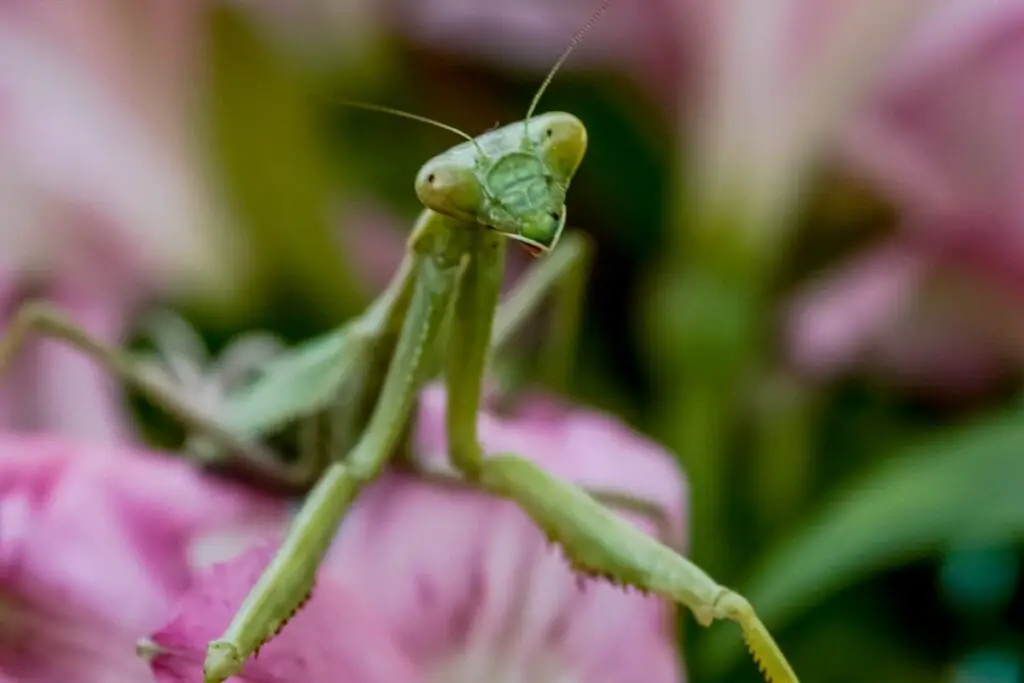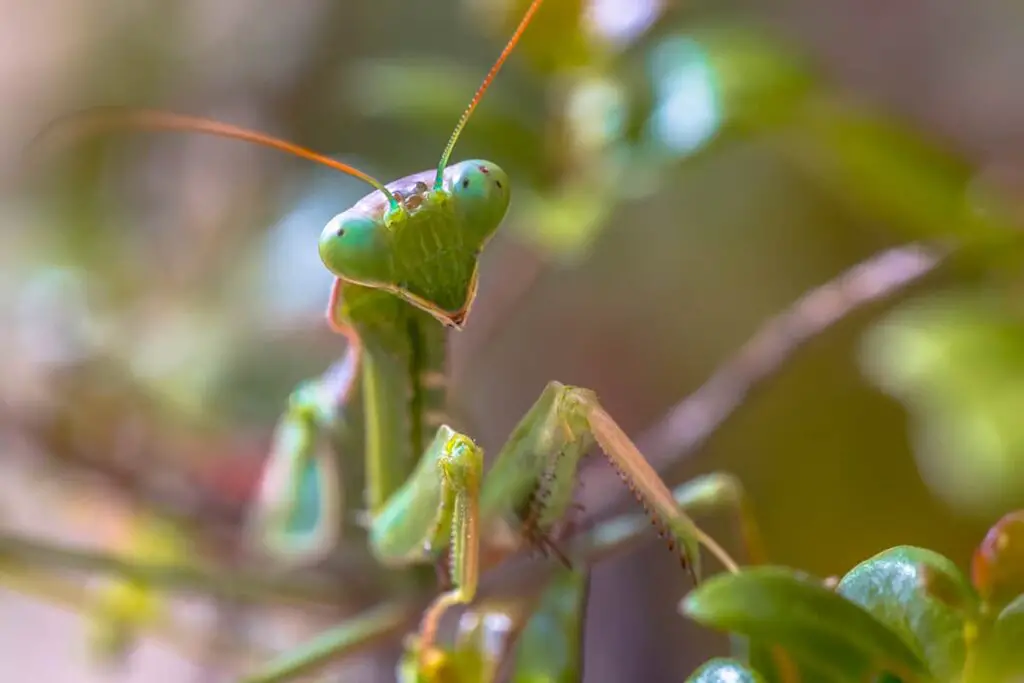Creating a habitat for a praying mantis can be an engaging project that brings a piece of the natural world into your home. These fascinating insects are not only interesting to observe but also beneficial for controlling pests if you’re into gardening. When setting up a habitat for your praying mantis, it’s important to ensure that it mimics their natural environment to keep them healthy and active.
Before you start building your mantis enclosure, take into consideration the space a mantis needs to thrive. Your habitat should be at least three times longer than the length of the mantis and twice its width to give it ample room to move and molt properly. Understanding how to select materials that are safe and suitable for your mantis, such as non-toxic wood and proper ventilation, is key to creating a space where your mantis can flourish.
Understanding Mantis Needs
Creating a suitable habitat for your praying mantis requires attention to their specific dietary needs, climate preferences, and space and shelter requirements to ensure a healthy and thriving environment.
Diet Requirements
Your praying mantis has specific dietary needs to stay healthy. They are carnivorous and primarily feed on live insects. Offer a variety of prey such as crickets, moths, and flies to provide a balanced diet. The size of the food should be appropriate, generally no larger than the head of your mantis.
Climate Preferences
Praying mantises flourish in warm climates, but their precise temperature and humidity needs can vary by species. Aim for temperatures between 75 to 85 degrees Fahrenheit and a humidity level around 40 to 70%. It’s crucial to regularly monitor these conditions to mimic their natural habitat.
Space and Shelter
Mantises need an enclosure that facilitates their natural behaviors. The general rule is that the enclosure should be at least three times the length of the mantis and twice its width. They require vertical space for climbing and molting, and the inclusion of sticks and foliage can provide necessary shelter and aid in maintaining humidity levels. Proper ventilation is also essential to prevent mold growth and provide fresh air.
Setting Up The Habitat
Creating a habitat for your praying mantis is crucial to their health and well-being. You’ll need to choose a location that mimics their natural environment, select an appropriate enclosure, and provide the right mix of substrate and vegetation.
Selecting a Suitable Location
Choose a spot in your home where your mantis can benefit from bright, indirect light to simulate natural day and night cycles. Avoid places with direct sunlight or drafty areas that could cause harmful temperature fluctuations. It’s important for mantises to have a consistent environment that is neither too bright nor too dark.
Enclosure Types and Sizes
For the enclosure, you’ll need something at least three times longer than the length of the mantis and twice its height to ensure enough space for movement and molting. A well-ventilated container—like a terrarium with a mesh top to prevent escapes—is ideal. The type of container is important as it must provide space and prevent injury by allowing free movement.
Substrate and Vegetation
Lay down a substrate such as soil or paper towels at the bottom of your enclosure for your mantis to walk on. This layer should be easy to clean and maintain. Adding live plants and branches not only makes the space more aesthetically pleasing but also offers the praying mantis places to hunt and hide, mimicking their natural habitat and providing them with mental stimulation.
Maintaining A Healthy Environment
Creating a suitable and stable environment is vital for your mantis to thrive. Ensuring proper temperature, humidity, and cleanliness will help mimic their natural habitat and promote health.
Temperature and Humidity Control
To keep your mantis healthy, maintaining the right temperature and humidity is critical. Your mantis requires a temperature range between 70-85°F during the day and a slight drop at night. Use a reliable thermometer to monitor the temperature within the habitat. Humidity should be around 60-70%, which can be checked with a hygrometer. To achieve this, mist the habitat with water once a day, but avoid overdoing it as excessive humidity can lead to mold growth.
Cleaning and Maintenance
Regular cleaning is essential to prevent mold and bacteria from harming your mantis. Remove any uneaten food, waste, and shed exoskeletons promptly. Clean the habitat with hot water and a mild disinfectant every four weeks, ensuring everything is thoroughly rinsed and dried before your mantis is returned to its home. Keeping the enclosure clean not only promotes better health but also allows you a clear view to enjoy watching your mantis.
Enhancing Mantis Well-Being
Ensuring the well-being of your mantis involves a dedicated approach, focusing on both environmental enrichment and prevention of health issues to support a thriving life.
Enrichment Activities
To keep your mantis mentally stimulated and physically active, incorporate various enrichment activities in the habitat. Live prey, such as fruit flies or crickets, is essential not only for nutrition but also to encourage natural hunting behaviors. Change the layout of the habitat occasionally by rearranging climbing sticks and foliage, which allows your mantis to explore and adapt to new surroundings. You can learn more about setting up these environments through guides like Creating a Mantis Habitat: Simple Setup Guide.
Preventing Common Health Issues
A key aspect of mantis care is preventing health issues before they arise. Proper ventilation is critical to prevent fungal infections, and maintaining a consistent temperature in the habitat is necessary to simulate natural conditions and boost their immune system. Avoid placing the habitat in direct sunlight or drafty areas, as recommended by experts who detail the importance of a controlled environment in guides such as How to Set up a Praying Mantis Habitat. Regular inspection for signs of stress or disease helps catch problems early, ensuring your mantis remains healthy.
Frequently Asked Questions
Creating a nurturing environment for your praying mantis is key to its health and longevity. These FAQs will guide you in setting up a proper habitat.
How can I create a suitable terrarium for keeping a praying mantis?
To create a suitable terrarium for a praying mantis, ensure the container is at least three times the length and twice the width of the mantis to provide ample space for movement and growth.
What are the essential elements to include in a praying mantis enclosure?
Your praying mantis enclosure should have proper ventilation, a heat source to maintain the right temperature, and structures for climbing and hiding. It’s also important to include a substrate for the floor and live plants for humidity and ambiance.
How can I maintain a healthy environment inside a praying mantis habitat?
Maintain a healthy praying mantis habitat by keeping the temperature and humidity levels appropriate, cleaning waste regularly, and mist the habitat with water daily to replicate a natural environment.
What size enclosure is ideal for housing a praying mantis?
A praying mantis thrives in an enclosure that is spacious relative to its size—typically about three times its body length in height and twice in width, to allow for molting and ease of movement.
How often should the habitat for a praying mantis be cleaned or maintained?
Clean the mantis habitat every few weeks to prevent mold and bacteria growth, with regular spot cleaning to remove uneaten prey or droppings.
Where can I find materials or kits to set up a praying mantis terrarium?
Materials or kits for a praying mantis terrarium can be sourced from pet stores, online retailers, or specialized insect habitat providers. Look for starter kits which can offer a convenient all-in-one solution.
Driven by a passion for those tiny creatures that rule our world, we at Bug Domain strive to be your go-to resource for information on insects.




